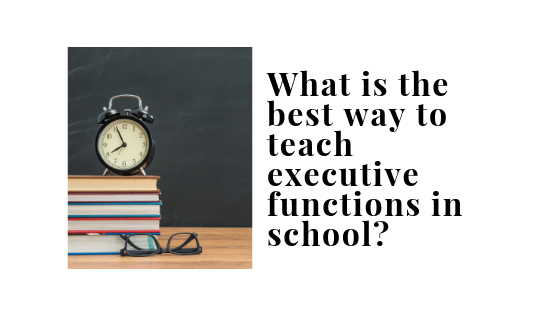An interesting question was recently posed to me: Should executive function skills be explicitly taught as a distinct part of a school curriculum?
This question was raised recently by an educational therapist who was enrolled in my course, the Teaching Seeing My Time Program. She shared her enthusiasm about the course with a teacher whose believed that executive function skills should not be taught as a stand-alone subject. Instead, this teacher felt that these skills should simply be integrated within other subjects. My student was confused by this response and wanted my perspective.
Looking to History for an Answer
To answer that question, I want to take you back in time to another brain/learning conundrum: Do we need to explicitly teach phonetic decoding skills to teach reading?
When I was getting my teacher training about reading instruction (back in the 70’s) the answer was no.
At that time, the approach to teaching reading was based on the belief that reading skills organically grew out of experience with language, starting with writing one’s own stories and rereading them. The belief was that reading and spelling awareness would develop as the student was motivated to communicate with the written word. For many students embedding letter sound combinations into writing and spelling worked, but for many many others, it didn’t.
Despite a robust and growing body of brain research supporting the existence of dyslexia (which requires explicit instruction for successful remediation), educators have picked sides on the debate for years. Explicit and direct instruction or embedded phonics instruction?
I suspect that standards of instruction for executive functions will follow the pattern of “either/or” that has surrounded teaching reading. From my experience (20 years as a reading specialist and 25 years of teaching executive function skills), a thoughtful incorporation of both approaches into daily curriculum is key – because they each have their place to meet the needs of the different kinds of students’ brains.
The Power of Direct Instruction for Key Executive Function Skills
I developed the Seeing My Time Program during my years as a reading tutor. I built the curriculum very carefully to foster successful learning, using the hands on, multi-sensory activities that worked so well in my reading instruction programs. In essence, SMT is a direct instruction program for teaching time-management, planning and organization skills. It works, not just for me, but for the now hundreds of people I have trained to teach the program.
We recently finished a Seeing My Time Family Group class, which had 32 participants. Most were students with their parents. On the first Saturday afternoon class, NONE of those students wanted to be in that room with me. Each young person was struggling in school due to executive functioning deficits. They were not responding to the efforts of their teachers and parents to help them. They were in pain. Their parents were in pain.
Change is Possible for Those Who Struggle
 At the last session, I had everyone in the room draw a picture of their future: of their dreams for the rest of their lives.
At the last session, I had everyone in the room draw a picture of their future: of their dreams for the rest of their lives.
I was stunned and humbled as I walked around the room at the scope of their dreams. One wanted to be a field biologist. A fifth grader wanted to invent something important. Another wanted to get into the Naval Academy and become a fighter pilot. One wanted to work for social justice. One wanted to design clothes. And a senior girl confidently said, “Something in science. Not sure what yet. That’s what I’ll figure out in college.”
At the end of that last class, I was surrounded by adolescents coming up to thank me – to give me hugs even – because they knew that I had explicitly given them the tools and self-awareness to reach their goals. In addition, their parents can now appropriately support their wonderful children and themselves.
I left the room knowing that those students now had the tools to make a positive difference in the world. These people NEEDED ten hours of direct instruction in order to help them to begin to believe in themselves, the first step to reach their full potential.
Next Steps for Teaching Executive Functions
Awareness of the importance of executive functions is still in its infancy. Many educators are wrapping their minds around how to teach them. Some approaches will be more effective than others. I will always fall into the group that understands the power and necessity of explicitly teaching time management, planning and organization from the perspective of the brain. I have seen it work, and change lives. Our world needs those bright, creative and compassionate minds that struggle with executive functions.
We don’t have to pick sides on how to teach executive function skills. Rather we all need to educate ourselves to understand the issues, the brain, and how to meet the needs of ALL children.
Join us in making a positive difference by teaching executive function skills!
Marydee


You are so right Marydee – just keep on keeping on!!!!!
Thanks for the encouragement, Brenda. You keep up your good work!
My Grandson, daughter and grandson Gabe have a April 18 530 appt with Ms Sklar. Is there anything to read prior to our first session?
Hi Donna, we sent you a private email with the answer to your question. Marydee is looking forward to working with you!